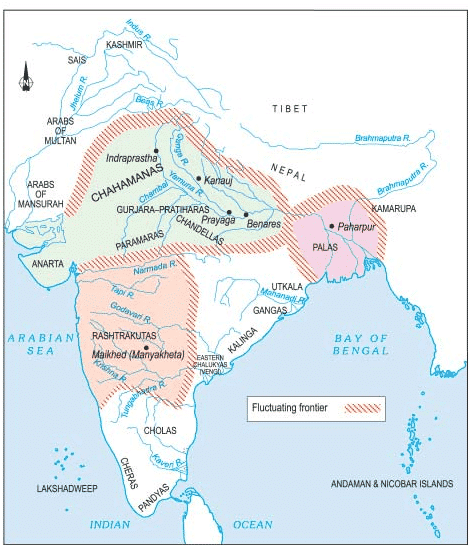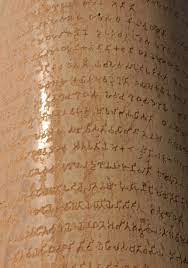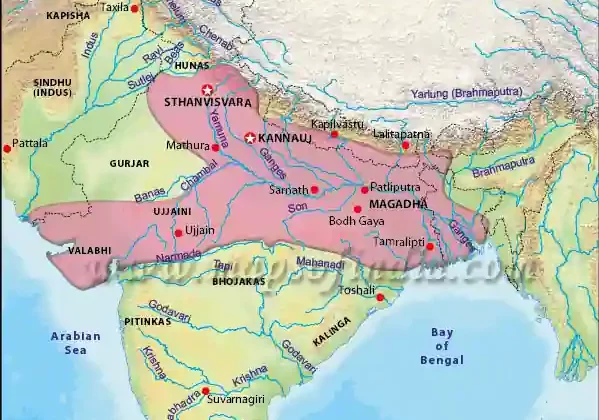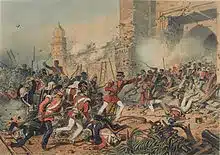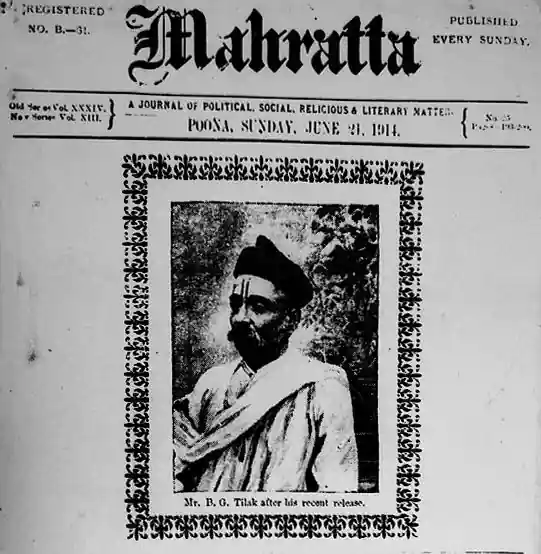To read this article in hindi, click here.
List of Important Ports of Ancient India
Lothal
- The oldest port in India, Lothal was an important port city of Indus valley civilization and was located in today’s Bhal region of Gujarat.
- Existed about 4500 years ago, the remains of the port city of Lothal were discovered in 1954 and were excavated by the Archaeological Survey of India (ASI) from 13 February 1955 to 19 May 1960.
- The excavations led to the discovery of a mound, a township, a marketplace as well as the dock, cementing the existence of the port in Lothal.
- According to Archaeologists, Lothal’s was an earliest known dock in the world and it linked the city to an old trade route that passed through Sabarmati river connecting Harappan cities and the peninsula of Saurashtra.
- It is believed to have been an important port that mostly saw the export of jewellery, textiles and mineral ores.
- Historical documents suggest the journey of valuable ornaments from Lothal all the way to countries in West Asia and Africa.
- It is said that the ancient engineers who built the port thoroughly studied the location and the tidal movements before constructing the port’s brick-built structures.
- The selection of an apt location allowed the vessels to use the highest tidal amplitude of the Gulf of Khambhat to rinse freely through flow tides in the river estuary.
- The dock also featured a lock-gate system, brick-paved passages and ramps leading to the dock in order to carry out loading easily.
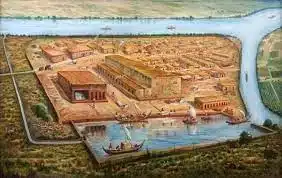
Sites of Indus Valley Civilization
Tamralipti Port
- Tamralipti was an ancient port city in Midnapur district, West Bengal.
- It is believed that Tamralipti was the exit point of the Mauryan trade route for the south and south-east.
- It was a port of Gupta era for the eastern India.
- Excavations at Moghalmari confirmed the presence of Buddhist vihars in the area which was mentioned by Chinese travelers Fa Hien and Xuanzang.
- It was located at the confluence of the River Rupnarayana and the Bay of Bengal and as such served as a natural seaport.
- Tamralipti is mentioned in the Markandeya Purana, the Vayu-Purana, the Natyasastra of Bharata, and the Brihat-Samhita of Varahamihira. Jain and Buddhist texts also speak of this port city.
- The Jatakas makes frequent references to voyages from Tamralipti to Suvarnabhumi (Myanmar/Southeast Asia) in connection with trade and missionary activities.
- The Arthasastra (3rd century BCE) contains profuse references to Tamralipti as an important centre of maritime trade.
- Ptolemy referred to it as Tamalities.
- Chinese pilgrims like Fa-Hien, Hiuen Tsang, and I-Tsing referred to Tamralipti as a port situated on a broad bay, a place suitable for embarkation bound for China.
- It is recorded in the Dudhapani Rock inscription of Udayamana (c. 8th century CE) that merchants from such distant places as Ayodhya (in the Awadh Kingdom) used to frequent this port city for the purpose of trade.
- The poet Dandin in his Dasakumara Charita referred to the coming of the Greeks to this port.
- According to the Kathasaritasagara, Tamralipti was a maritime port and an emporium of commerce in the 4th century CE.
- Since Tamralipti (Tamluk) was the nearest seaport for visiting the main centres of Buddhism in India such as Rajagriha, Sravasti, Pataliputra, Bodhigaya, Sarnath, Champa, Nalanda, Kaushambi, and other places, Buddhist travellers’ from different parts of the world who came by sea landed here and from here went to various places.
Bharuch Port
- Almost 2000 years ago, Bharuch was a prominent port in the Indian subcontinent region and also one of the most important cosmopolitan cities around the world then.
- Broach was a major port during the Mauryan period.
- Located in the region that comes under the current state of Gujarat and at the mouth of the river Narmada, Bharuch was also known as Bharukaccha and Barygaza to the merchants from around the world.
- Bharuch had established trade relations with Arabs, Greeks and Romans, Africans, Chinese and Egyptians.
- Historians suggest that the history of this port and shipbuilding centre goes back to the days of the Pharaohs.
- Bharuch was a terminus for a number of land-sea trade routes and goods were trans-shipped there to send abroad utilising the monsoon winds.
Muziris
- Muziris, the ancient port city located in today’s Indian state of Kerala, was one of the most important trading ports in the world almost 2,000 years ago.
- Existed in the first century BC, the Muziris port had played a significant role in connecting the region with the Persians, the Phoenicians, the Assyrians, the Greeks, the Egyptians and the Roman Empire.
- While spices, particularly black pepper, were the key item exported from the Muziris port, other commodities shipped include semi-precious stones, diamonds, ivory and pearls, among others.
- According to historians, the goods arrived at Muziris from over 30 countries were mostly textile, wine, wheat and gold coins etc.
- However the exact location of the port remains unconfirmed, many historians and archaeologists believe the port and the adjacent city located around present-day Kodungallur, few miles away from the Cochin port in Kerala.
- Muziris remained as a legend for a long period of time until the Kerala Council for Historical Research started a series of excavations in 2006, leading to the discovery of evidence that confirmed the history of Muziris port.
- It also believed that the golden period of the port and city came to an abrupt end in 1341 after a tsunami wiped off this central point of the well-known spice route.
Sopara Port
- Sopara was an ancient port town and the capital of the ancient Aparanta.
- The ancient port of Sopara was the most important port in western India after the celebrated port of Cambay.
- The site of this ancient town is located near the present day Nala Sopara (Mumbai).
- In ancient times, it was the largest township on India’s west coast, trading with Mesopotamia, Egypt, Cochin, Arabia and Eastern Africa.
- The Mahabharata and the Puranas state that the Śūrpāraka was reclaimed from the sea for the dwelling place of Parashurama and it became a tirtha for this reason.
- The finding of the relics in a stupa and the rock edicts (the fragments of the 8th and 9th major rock edicts) of Ashoka in 1882 prove the importance of this port town from the 3rd century BCE to the 9th century CE.
- The Sanskrit text Mahavamsa states that the first king of the Sinhalese Kingdom (now Sri Lanka), Vijaya sailed from Supparaka (Sopara) to Sri Lanka, mentioned this town as Soupara, and it was a major commercial centre during his time.
- According to the Jaina writers, Shripala, a mythical king married Tilakasundari, daughter of king Mahasena of Soparaka.
- Jinaprabhasuri (14th century) in his Vividhatirthakalpa mentioned Soparaka as one of 84 Jaina tirthas (sacred places). He also mentioned about an image of Rishabhadeva located in this city till his time.
Poompuhar
- Poompuhar, also known as Puhar, is believed to be the Port town of Chola Empire.
- Located in the current Nagapattinam district in Tamil Nadu, the ancient ports city, also named as Kaveripoompattinam in historic documents, was reportedly situated in the mouth of the Kaveri River.
- Details about the port city have been found in several historic documents including Periplus of the Erythraean Sea.
- According to historians, the port witnessed the Indian merchants trading their commodities, mostly spices, with other Asian countries as well as Arabs.
- It is said that the goods arrived in the port included horses from Gulf countries and finished goods from neighbouring regions such as Sri Lanka and Indonesia.
- Several of explorations have been carried out in Poompuhar and adjacent areas, starting from 1910, leading to the discovery of evidence including the remains of buildings and ring-wells.
- According to the archaeologists, the result of these excavations points the history of the ports to 3rd century BC. And, many believe that the port city was destructed after the storm and the following erosion occurred during 500 AD.
Arikamedu
- Arikamedu, located in today’s Puducherry, a union territory of India, is known as the port of Podouke in historical documents.
- With mentions in the Tamil poems of the Sangam period, Arikamedu is believed to be an active trading port of the region with the Roman Empire as early as second century BC.
- Many believe that Arikamedu was a Chola port dedicated to bead making and it was the only port city in the region to have ties with Romans.
- In addition, textiles, terracotta artefacts, plants, spices and jewellery were also shipped from the Indian port to Roman ports and other eastern destinations.
Tuticorin Port
- Tuticorin or Thoothukudi port is one of the oldest seaports in India, with having been established as early as 6th century.
- Located at 550 km South West of today’s Chennai, Thoothukudi was ruled by several dynasties including the Pandyas and the Cholas in the past, often using it as their important seaport.
- The most important trade in this region included fishery and pearl.
- The earliest mention of the port has been made in Periplus of the Erythraean Sea.
- Later, Tuticorin was established as one of the most important shipping ports under the rule of the Dutch and English.
- Under the western rule, the port was used for the export of palmyra fibres, senna leaves, salt, dry fish, etc. and the import of commodities such as cotton, pulses, grains and coal, among others.
- Currently known as V. O. Chidambaranar Port, and one of the major ports in India.
Also refer :
- Download the pdf of Important MCQs From the History Of Ancient India
- List Of Important Inscriptions In India


